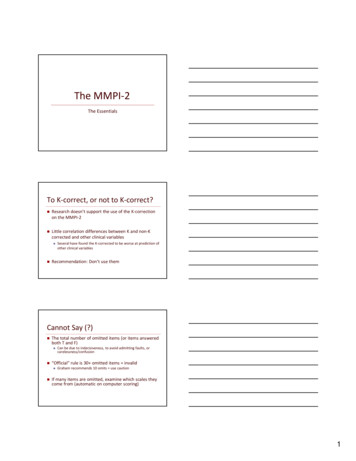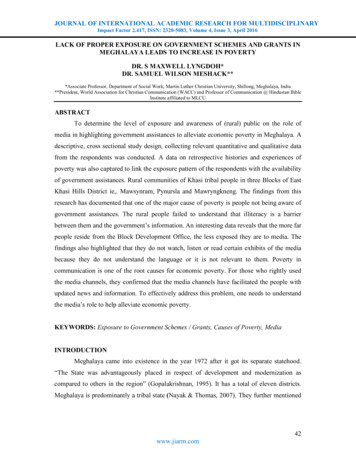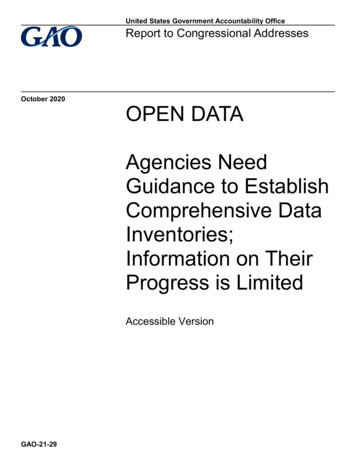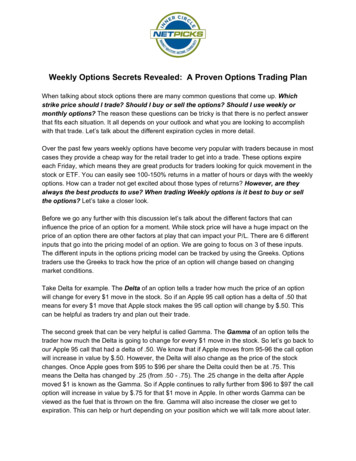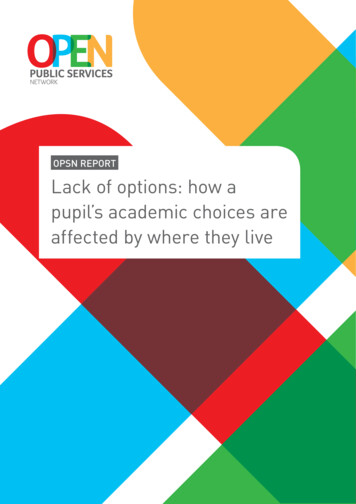
Transcription
OPSN REPORT 2015 OPSN REPORTLack of options: how apupil’s academic choices areaffected by where they live01
Contents03050809Access to triple science11Regional variations in enrolment15Subjects per pupil24IntroductionForewordKey findingsSetting the sceneSimilar challenges, differing outcomes27Case studyJohn Smeaton Academy, Leeds30Methodology33About OPSN34Open Public Services NetworkRSA8 John Adam StreetLondon WC2N 6EZAll our data is freelyavailable for secondary use.Download athttp://goo.gl/I8ld5aAll our data is freely available for secondary use. Download at www.xxx.yyy
OPSN REPORT 2015 INTRODUCTION03Are there subject desertsin parts of the country?Charlotte AlldrittRoger TaylorThis project, kindly supported by Leeds City Council, compares data across regions and cities, toenable policy makers to understand the overall pattern of provision and attainment in their areas.We focus on the availability of GCSE subjects as a first step in considering the extent to which citiesoffer a range of academic opportunities to young people. While most places offer a fairly wide rangeof subjects (beyond mandatory English and Maths), our analysis shows that ‘subject deserts’ exist incertain parts of the country. This potentially limits young people’s options for further study and/or intheir career choices.Want to be a doctor, but can’t get access to three sciencesat GCSE? Then catching up at A Level or applying tomedical school without a particular subject makes accessto this profession – already limited in its social diversityof intake – more difficult still.We have focused on the variability of the opportunity to take GCSEs as an indicator of variation ineducational opportunity. However, we recognise that for many pupils, alternative qualificationsand pathways are key to unlocking their employment potential. We have also included an analysisof access and take-up of BTEC science to complete the picture. We look to future projects toexamine this further, and actively support efforts in the Department for Education and Business,Innovation and Skills to welcome secure linkage of National Pupil Database, FE college data, schooldestinations and HMRC data. Only then can we get a clear understanding of how well our educationand skills systems are preparing young people to be happy, resilient and productive citizens.
INTRODUCTIONOPSN REPORT 2015 04Our analysis raises a number of concerns about the impact of education policies on the opportunitiesopen to young people. There is concern that the accountability regime – in which schools are ratedon the number of points they achieve in exams – can incentivise schools to offer more limitedopportunities to children in an effort to maximise the school’s rating at the expense of the child’sfuture. Children from more deprived areas tend to get poorer grades than children from moreaffluent areas. Schools in these areas can improve their chances of better grades by only offeringless demanding courses. Evidence that this may be occurring can be seen, for example, in the muchlower rates of enrolment for triple science GCSEs in more deprived areas.The data analysed here are for the three years to 2013 and predate the reform of the accountabilityregime following the review of vocational qualifications by Alison Wolf1. These reforms mean thatmany of the qualifications that were regarded as less demanding no longer count towards theschool’s performance. We will be returning to this question later this year to assess the impact ofthese changes on the levels of enrolment in GCSEs in 2014.Another issue raised by the analysis is the role of local education authorities (LEAs) in shapingeducation services within a region. The data show that within some areas there may be no schoolsoffering the opportunity to study triple sciences or modern languages. As responsibilities have beendevolved to individual schools, LEAs may not be able to require changes. However, they may be ableto play a vital role in bringing people together and co-ordinating activities across a region to providethe widest possible opportunities to children.AcknowledgementsOPSN would like to thank Leeds City Council and the Children’s Services department, particularlyClare Walker and Peter Storrie, for their help for their continued expertise throughout. We wouldalso like to thank Paul Charman and Dave Thompson at FFT2, and Alex Kafetz, Melissa Clements andAshling Allen at ZPB Associates 3. Finally, thanks to Joe Hallgarten and the RSA 4 and their continuedsupport of OPSN as a thought leader in the emerging world of open data powering creative,productive public services and www.thersa.org/
FOREWORDSubject variation OPSNbasedREPORTon location 2015 201505 Information that will startconversation and shapebetter public servicesProviding access to open data is something that Leeds City Council is verypassionate about, as demonstrated through our Leeds Data Mill project.5We see this as a great opportunity for not only making data available, but allowingpeople to look at data in a different way. This new approach to data can enablepeople to come up with new ideas and solutions for addressing city issues, bethat traffic congestion or identifying safe places for children to play. It’s in thiscontext that we have recognised the opportunity to link up with the OPSN in thecity education data project.As a child-friendly city we in Leeds are committed to improving the learningopportunities available to our young people and to supporting them to make thelearning choices that are right for them. The quality of young people’s learningwill shape their adult lives, helping to determine their commitment to ongoinglearning and influencing their employment prospects. We must provide the bestopportunities for our young people to prosper, achieve and contribute as part of agrowing Leeds economy and an evolving Leeds community.In supporting OPSN with this piece of work we are helping contribute to stimulateconversations in schools and at national and local levels on what is the rightlearning offer for our children and young people. We are committed as anauthority to making information available, not in order to presume answersbut to start conversation, and to help shape better public services. It is vital tocollectively inform and contribute to how we deliver the best opportunities forour young people.05
FOREWORDOPSN REPORT 2015 Employers and those providing further and higher education must help to informdecisions. Schools will continue to consider and deliver what is in the bestinterests of the young people and communities they serve. Young people andparents need to understand the choices available and where they lead post-16.Our case study (page 30) demonstrates a positive journey being made by JohnSmeaton Academy in Leeds, which has re-shaped its science curriculum offerand has a keen focus on work readiness through excellent links with businesses.We hope this work contributes to conversations at all levels on science andlanguage in the GCSE curriculum, and then into broader debates on the learningoffer. Should we regard modern foreign language as an academic speciality ormore realistically in 21st-century Britain as an expectation for all young people?Is science at GCSE about opening minds and encouraging insight that will leadsome to follow science through to university and beyond, or is it also the basis ofa range of post-16 learning and career opportunities for others?Given the changes schools are addressing and their desire to do well for theiryoung people we hope this work provides ongoing and useful insight that can helpinform local decisions on the curriculum offer and in doing so have a positiveimpact on the opportunities, aspirations and outcomes for children and youngpeople in Leeds and across the country.Councillor Judith Blake, Deputy Leader of LCC and Executive Member forChildren and FamiliesTom Riordan CEO, Leeds City Council5http://www.leedsdatamill.org06
OPSN REPORT 2015 Want to access ourdata? Read more onthe RSA websiteRoger Taylor, Chair of OPSN and RSA Fellow, said:“These data show that children’s educationalopportunities are defined by where they live.”Download data:GCSE enrolmentdata 2013-1407
INTRODUCTIONOPSN REPORT 2015 08Unequal opportunities The curriculum a pupil will be taught in an English schoolvaries according to whether they live in a wealthy or poorneighbourhood. In North East Lincolnshire half the schools entered no childrenfor triple science. In Medway, Knowsley, Slough, Kingston uponHull and Newcastle more than a third of schools do not enterany pupils for triple science. In contrast, in Sussex andCumbria every school has at least some pupils takingGCSEs in three sciences. Children in Knowsley are half as likely to be enrolled fora science GCSE as children in Buckinghamshire. Children in Kensington are four times more likely to be enrolledfor a language GCSE than children in Middlesbrough where, onaverage, only one child in every four takes a language GCSE. Children are most likely to be entered for an art GCSE inPortsmouth and least likely in Kingston upon Hull, where it isfour times less likely.All our data is freely available for secondary use. DownloadAll our dataat iswww.xxx.yyyfreely available for secondary use. Download at www.xxx.yyy
SETTING THE SCENEOPSN REPORT 2015 09Re-presenting data inengaging formatsThe Open Public Services Network is committed to publishing information to inform publicunderstanding and scrutiny. By presenting existing data in an intelligent way, and creating newanalysis and datasets, we aim to enable researchers and policy makers to compare the performanceof public services, hold them to account and lobby for changes and improvements.This report, supported by Leeds City Council, pays particular attention to enrolment for GCSEs andthe variation in different local education authorities (LEAs). Our main focus has been on the sciences,as little access to one or more sciences at GCSE can curb or at least make harder careers choices inthe future such as medicine, biochemistry and life sciences. We are using enrolment as a proxy foraccess. Where schools have low uptake rates, it may of course mean that subjects were available butno or few pupils decided to take them. This is unlikely, and begins another debate about why theseare not being promoted or encouraged.We present our analysis of the access data, and as evermake the full dataset available for others to explore anddraw their own conclusions.www.thersa.org/opsnWe invite comment and raise a number of emerging issues and questions throughout the report.We hope headteachers and governors will find this interesting and use the information to plancurriculums and staffing numbers in the future, and LEAs will use it to ensure they are giving pupilsunder their care the best possible access to the widest range of subjects.There is no set criteria for how a pupil chooses which GCSEs to take. Pupil choice and school choiceare normally the limiting factors. Most schools implement some kind of selection criteria, e.g. pupilsmust do at least nine GSCEs including English and Maths. They must do at least one humanitiessubject, a language and a science, and then have four free choices. There are also limitations, as thisreport shows, on what the school is able to offer. They might not, for example, have the teaching stafffor music or a particular language.Also, for the last few years, some LEAs have had relatively little input into school improvement, sothis analysis, while interesting, needs to be interpreted with care. We also have not looked at theimpact of large academy chains.
SETTING THE SCENEOPSN REPORT 2015 10A substantial part of this report looks at the uptake of three science GCSEs and we have used theshorthand “triple science” to refer to this. We measured this to gain an understanding of eachschool’s approach but recognise this does not necessarily measure its commitment to science.For example, some strong academic schools are not offering triple science at GCSE but will at ALevel. Additionally, schools offering triple science don’t always have the highest percentage of pupilsparticipating in science. Some schools have committed to core and additional science and take-up ishigh. Some schools offer triple science to a small class but overall have low core/additional sciencetake-up. As ever, more data is required before conclusions can be made. We need to understand theimpact at A Level and on university choices. For example, is there an evidence base that not offeringtriple science has an impact?It is expected that we will see changes in the results in future years as schools remodel theircurriculums in response to national changes, including accountability. As a result this work willpotentially become even more valuable, especially for school leaders’ understanding of changingpatterns. Specifically, the impact of first entry needs to be seen; while being about school and LEAaccountability it can change which subjects schools offer to pupils and this may effect young people’spathways into learning and jobs. The OPSN is committed to updating this dataset next year.Note on taxonomy:We have used subject groups defined in the RM education school finder6. This groups thewide number of GSCEs available into 18 clusters of subjects. ‘Science’, for example, includesadditional science, applied science, astronomy, biology, chemistry, environmental science,geology, physics, science (core), and double award science.Note on deprivation quintiles:We have used percentage of pupils receiving free school meals as a proxy for understandingthe deprivation of each LEA. This is standard practice when analysing education data (it isused by the
Read more on the RSA website Download data: GCSE enrolment data 2013-14 Roger Taylor, Chair of OPSN and RSA Fellow, said: “ These data show that children’s educational opportunities are defined by where they live.” .
